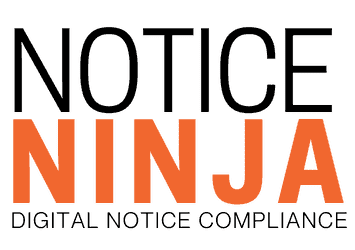Yes, NOTICENINJA is corporate tax notice compliance software that automates key workflows including notice assignments. The platform employs a rule-based system that can manage multiple level rules and ensure notices are directed to the appropriate stakeholder. As a result, you’ll never have to worry about notices being misdirected or slipping between the cracks.

AI in the Tax Department: Skills, Trust, and the Future of Compliance

30 October
Why AI Is Reshaping Corporate Tax
Imagine your tax team as a starship crew charting unexplored sectors. Adopting AI is like acquiring a new warp drive that enables faster, smarter journeys, yet it also requires new navigational know how. In corporate tax, AI now powers intake and resolution for tax notices, audits, amended returns, refund checks, and entity registrations. Teams use predictive analytics to surface risk by jurisdiction and account, while automation removes repetitive steps, so professionals focus on research, negotiation, and strategy.
The New Skills Mix For Modern Tax Teams
Multidisciplinary talent is now essential. Data analysts, compliance technologists, and AI trainers work with tax managers and directors across IT, legal, and finance. This mix safeguards privacy, strengthens audit readiness, and keeps model improvement continuous. Training is hands on and grounded in realistic scenarios from federal, state, and local agencies, including examination letters, power of attorney workflows, and settlement modeling for complex entities across multiple states.
Actionable insight requires new metrics. Tracking only deadlines or volume is not enough. Leading teams monitor speed of decisioning, variance reduction in outcomes, and predictive accuracy for risk flags by agency and notice category. Think of the shift from batting average to advanced analytics. These measures create a results-oriented culture that rewards agility, precision, and consistency across the full life cycle of a case.
Preserving Institutional Knowledge At Scale
When experienced staff retire or change roles, critical knowledge can vanish. AI platforms provide a durable memory that captures best practices, template language, research paths, and outcomes. A searchable library lowers training costs, improves consistency, and accelerates response when rules shift. For corporate groups, this shared memory spans business units, portfolio companies, and locations, so proven playbooks replicate quickly across the enterprise.
Compliance, Ethics, And Trust
AI success depends on responsible data handling, unbiased decisioning, and clear communication of AI assisted recommendations. Tax leaders should define how models are trained, what data is used, and how results are reviewed and approved. Regular audits of outputs and workflows, with documentation of decision paths, build trust with leadership and external auditors. Teams must be ready to explain why a risk flag appeared, which features influenced it, and how human judgment finalized the action. Much like Tony Stark working with JARVIS, teams need to balance digital assistance with human judgment and sign off.
Stronger governance turns experimentation into durable practice. Create a taxonomy of notices and outcomes, define process owners, and publish service level targets for intake, research, response, and closure. Track exceptions and root causes, then feed those insights into model tuning and training plans. Establish a cross functional review board from tax, legal, security, and internal audit. Write and test controls for model access, data retention, vendor oversight, and incident response using exercises that mirror real agency requests.
Integration And Automation Across The Enterprise
Impact rises when AI connects to the systems your teams already use. Corporate tax departments benefit from integrations with ERP, treasury, document management, and case management tools. Automated ingestion with OCR and machine learning classifies notices, extracts key fields, and opens cases with the correct workflow template. Configurable alerts drive on time responses, multi entity and multi-location tracking helps leaders prioritize effort, and advanced reporting provides a single view of risk across entities and states. These same capabilities support CPAs, private equity platforms, commercial banks, and service providers that manage large, distributed portfolios.
Modern programs pair operational metrics with executive reporting. Track first touch resolution rate, false positive and false negative rates for risk flags, forecast accuracy for remediation timelines, user adoption, training completion, and satisfaction. Scorecards should roll up by agency, account, and location, making it simple to allocate budgets, prove value, and direct resources where they matter most.
Invest In People
Tools do not replace expert judgment. They amplify it. Build a bench of power users who can explain model behavior, analysts who test assumptions, and leaders who translate outcomes into business impact. Encourage certifications, internal demos, and communities of practice so winning patterns spread across teams and portfolio companies. Celebrate cases where automation prevented penalties, accelerated refunds, or uncovered systemic issues that manual review would miss.
Modernize Corporate Tax Operations: Demo, Pricing, and Pilot
Ready to upgrade corporate tax at scale? NOTICENINJA delivers automated alerts, OCR driven intake, AI classification, and automated response workflows for audits, notices, amended returns, refund checks, and entity registrations. Integrations connect with your ERP, document management, and identity platforms so multi entity and multi-location tracking is seamless.
- Book a demo to see risk flagging, workload routing, and advanced reporting.
- Request a Consultation to ensure alignment with your entities, jurisdictions, and volume.
- Start with a pilot that activates customizable workflow templates and connects to your systems within a short implementation window.
RELATED POSTS
- How NOTICENINJA's AI is Automating the Back-Office
- Where AI Falls Short in Tax Notice Compliance | Notice Ninja
- Automating Corporate Tax Compliance Strengthens Controls and Reduces Risk
